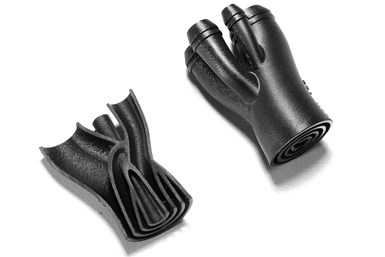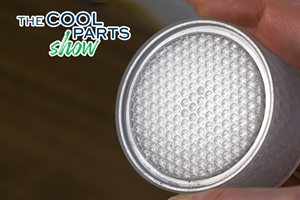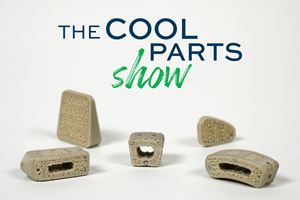Carbon’s EPX 150 Is High-Performance Rigid Resin for Complex Parts, Features
EPX 150 is Carbon’s fastest printing, chemically-resistant, high-temperature resin which is purpose-built to print complex parts and features.
Carbon’s EPX 150 is a high-performance rigid material that will be available on Carbon’s idea-to-production platform. It enables new capabilities in applications that requires high temperature and chemical resistance such as electrical connectors, spray nozzles and autoclavable medical devices. The material is now available in Europe and North America.
EPX 150 offers better temperature and chemical resistance than EPX 82, and better toughness and overall usability than CE 221. As Carbon’s fastest printing, high-temperature resin to date, it is designed to print complex features at faster speeds, making it suitable for parts with fine features and stringent tolerances.
“Designers and engineers need materials that provide the combination of accuracy, repeatability and throughput to produce the many complex parts they are designing at scale — EPX 150 provides that,” says Jason Rolland, senior vice president of Materials at Carbon. “With EPX 150 and Carbon’s technology, we’ve created a manufacturing-ready additive process with materials that are able to match the capabilities of high-performance thermoplastics that will enable prototyping and manufacturing to be done on a consistent platform, accelerating the product development time lines and reducing the cost.”
With the addition of EPX 150 to Carbon’s idea-to-production platform, users will now have a combination of high-performance material properties, excellent resolution and attractive economics to make the production of complex, rigid parts achievable in shorter times, without molding investments.
Benefits of EPX 150 include thermal performance with a heat-deflection temperature (0.455MPa) of 155°C and the capability of extended use at 125°C. It also offers exceptional chemical resistance at elevated temperatures for automotive/industrial applications, particularly to polar fluids like water, coolant/antifreeze and aqueous washing fluids. For medical applications, EPX 150 is capable of withstanding 250-plus cycles of steam sterilization autoclave cycles with no significant mechanical and visual changes.
The material also provides low dielectric constant and loss factor suitable for advanced electronic applications. It is designed to print fine complex features at faster speeds, with improved cleaning and longer pot life, thereby enabling higher production efficiencies.
- Read about Desktop Health partnering with Carbon to validate Flexcera resins for Carbon’s digital manufacturing platform. The first Flexcera family resin validated for Carbon systems is Desktop Health’s Flexcera Smile Ultra+, an FDA 510(k) cleared Class II material for permanent, 3D printable dental restorations, to be followed closely by Flexcera Base.
- Learn more about Carbon resins in this article about expanding its resin materials portfolio. The three resin materials — Carbon EPU 43 and EPU 45, and Henkel Loctite IND147 — offer impact protection, highly breathable lattice geometries and a low-cost, fast alternative for producing low-pressure moldings, baking fixtures and small components with complicated geometries.
Related Content
Cranial Implant 3D Printed From Hydroxyapatite Ceramic: The Cool Parts Show #76
Cranial implants are typically made from titanium or PEEK; in this episode of The Cool Parts Show, we look at how implants made from a bioceramic can improve osseointegration and healing.
Read MoreUltra-Complex 3D Printed Scaffolds Enable Cell Growth: The Cool Parts Show #70
Perhaps the ultimate surface-area challenge is in bioengineering: creating structures that can grow sufficient cells within a compact volume to be effective for leading-edge medical treatments. The Southwest Research Institute develops bioreactor scaffolds that could only be made using 3D printing.
Read MoreFDA-Approved Spine Implant Made with PEEK: The Cool Parts Show #63
Curiteva now manufactures these cervical spine implants using an unusual 3D printing method: fused strand deposition. Learn how the process works and why it’s a good pairing with PEEK in this episode of The Cool Parts Show.
Read MoreActivArmor Casts and Splints Are Shifting to Point-of-Care 3D Printing
ActivArmor offers individualized, 3D printed casts and splints for various diagnoses. The company is in the process of shifting to point-of-care printing and aims to promote positive healing outcomes and improved hygienics with customized support devices.
Read MoreRead Next
3D Printed Polymer EOAT Increases Safety of Cobots
Contract manufacturer Anubis 3D applies polymer 3D printing processes to manufacture cobot tooling that is lightweight, smooth and safer for human interaction.
Read MorePostprocessing Steps and Costs for Metal 3D Printing
When your metal part is done 3D printing, you just pull it out of the machine and start using it, right? Not exactly.
Read MoreAlquist 3D Looks Toward a Carbon-Sequestering Future with 3D Printed Infrastructure
The Colorado startup aims to reduce the carbon footprint of new buildings, homes and city infrastructure with robotic 3D printing and a specialized geopolymer material.
Read More





















